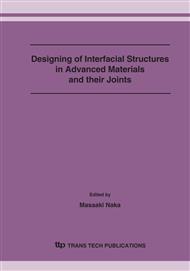p.3
p.9
p.15
p.19
p.25
p.31
p.37
p.43
p.51
Interfaces in Joints and Composites Composed of Hard Materials and Metals
Abstract:
Currently there is an increasing demand for composites and joints composed of hard materials, such as ceramics, superabrasives or metal-carbides, and metals. Wear pads, welded or brazed machining tools or composites employed for grinding tools are typical fields of application. All those various materials solutions have in common that there are interfaces between materials that typically have a covalent or ionic bonding and metals. Consequently, wetting and bonding problems arise. The paper presents different examples and discusses them with emphasize on the corresponding interfacial interactions. Furthermore measures are analysed that can be taken to influence the intensity and strength of the interfacial bonding between the materials to be joined.
Info:
Periodical:
Pages:
25-30
Citation:
Online since:
September 2007
Authors:
Keywords:
Price:
Сopyright:
© 2007 Trans Tech Publications Ltd. All Rights Reserved
Share:
Citation:


